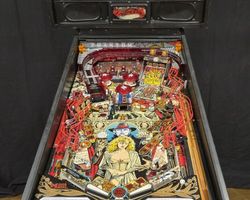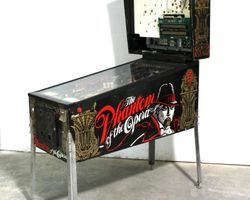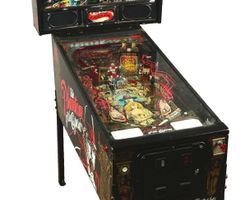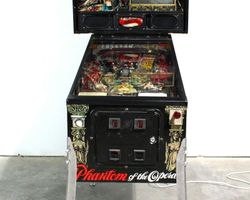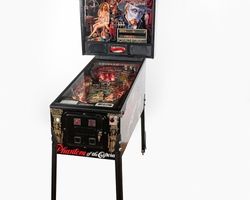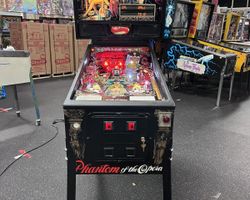Phantom of the Opera
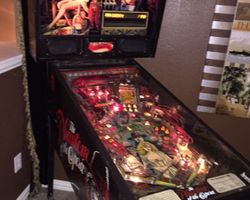
Average Prices: USD $600 to $2,700
Produced: January, 1990
Production Run: 2,750 units
Machine Type: Solid State Electronic
MPU: DataEast/Sega Version 2
Players: 4
Design by: Ed Cebula, Joe Kaminkow
Art by: Paul Faris
Music by: Kyle Johnson
Sound by: Kyle Johnson
Software by: Lonnie D. Ropp
Data East’s Phantom of the Opera pinball machine, released in January 1990, emerged into an arcade landscape evolving with more complex solid-state designs. This machine draws its theme directly from Gaston Leroux’s 1910 French novel, The Phantom of the Opera, rather than the more contemporary Andrew Lloyd Webber musical. This distinction allowed Data East to craft a visual and auditory experience rooted in the classic gothic horror narrative.
The creation of Phantom of the Opera involved a dedicated team. Joe Kaminkow and Ed Cebula spearheaded the design, shaping the game's core mechanics and layout. The artistic vision was brought to life by Paul Faris, whose work on this title remains a focal point of its enduring appeal. Paul Faris himself noted that his daughter served as the model for the Christine Daaé character depicted on the backglass. Kyle Johnson was responsible for the machine’s distinctive music and sound design, while Lonnie D. Ropp handled the software. With a production run of 2,750 units, Phantom of the Opera represented a significant release for Data East, aiming to capture the imagination of players with its dramatic theme and engaging gameplay. An interesting facet of its early production involved a small batch of around ten machines, including serial number 009, sent to a Bose speaker factory. These units received enhanced speakers and amplification, intended to showcase Data East's evolving sound system. Beyond these specialized audio setups, and reportedly some early ROM sound bites, no significant differences have been identified between these early production models and later units, aside from the color of some under-playfield lamp boards.
Signature Features and Design
Phantom of the Opera is defined by several standout elements that contribute to its atmospheric presence and gameplay. Foremost among these is the "Organ" mechanism, a raised ramp in the upper-right playfield. This feature can be activated by striking three targets above it or by executing a precise skill shot from the plunger. Once open, the Organ allows the ball to drop into a sub-playfield cavern, a visually striking representation of the Phantom's lair beneath the opera house. This mechanical ingenuity provides a central objective and a strong visual payoff, aligning directly with the machine's theme.
Another notable feature is the "Magic Mirror," a sinkhole positioned below the pop bumpers. This element functions as a bonus multiplier accumulator, advancing the bonus up to 5x. Its placement and function encourage players to aim for the upper playfield, adding a layer of strategic depth beyond direct shots. The playfield also incorporates a swinging target and a hanging target, adding dynamic elements that alter shot paths and require precise aim. A left outlane kickback provides a last-chance save, maintaining the flow of gameplay and adding to the challenge. Paul Faris's artistic contributions are widely regarded as a pinnacle of pinball artwork. The playfield, backglass, and cabinet art are meticulously detailed, employing mirroring effects and gothic motifs that perfectly encapsulate the opera house setting and its underlying mystery. The rich blues, purples, and reds, combined with intricate architectural elements and character depictions, create a captivating visual narrative. This visual artistry is complemented by Kyle Johnson’s sound design, which features dramatic organ swells and eerie sound effects that immerse the player in the world of the Phantom. The music and sound effects are often cited as a cohesive and masterfully executed aspect of the machine, perfectly fitting the thematic requirements.
Playfield and Mechanics
The playfield layout of Phantom of the Opera features a relatively open design with distinct objectives that promote varied shot-making. At the bottom, two standard flippers control the ball, set with ample space between them, leading to a sometimes-brutal playing experience. The left outlane is equipped with a kickback mechanism, which can be activated to save a draining ball, offering a crucial second chance. The left inlane, when lit, energizes the spinner for a "Mystery Score," encouraging players to send the ball up the left side.
Higher on the playfield, two three-bank sets of standup targets, "Grasshoppers" and "Scorpions," are strategically placed. Hitting these targets can award points, hold bonus, light extra ball, or light special, providing immediate goals for players. A prominent red plastic ramp, dubbed the "Catwalk," arcs from the lower-right playfield to the right inlane. Shots up this ramp advance letters towards spelling "PHANTOM," with each successful shot scoring 20,000 points plus an additional 5,000. Completing the word lights the ramp for unlimited one-million-point shots, a high-scoring objective that often becomes a primary focus for players.
At the top of the playfield, three rollover lanes initiate a "Jackpot Build" round when completed. These lanes also illuminate the spinner for enhanced point values per spin. Below these lanes are three standard pop bumpers, positioned to create lively, unpredictable ball action. The "Magic Mirror," a sinkhole beneath the bumpers, is crucial for advancing the bonus multiplier up to 5x. The "Organ," situated in the upper-right, is the central mechanism, requiring hits to its three contact targets or a precise skill shot from the plunger lane to open. The "Spinner," leading into a half-orbit, is a primary entry point for loop shots, accumulating points with each revolution. Below the spinner is the "Trap Door," another sinkhole that delivers a range of random awards, including points, special, extra ball, the coveted "Open the Organ," multiplier advances, double jackpot, lit bonuses, and a lit "Phantom Shot." The overall aesthetic of the playfield, with its deep colors, detailed artwork, and strategic lighting, enhances the gothic theme, drawing players into the machine's dramatic narrative.
Gameplay Dynamics
The gameplay of Phantom of the Opera revolves around a progression of distinct objectives and scoring opportunities. The game commences with a skill shot: a properly plunged ball that drops into the flashing top lane awards 100,000 points multiplied by the number of balls in play and immediately opens the "Organ" mechanism. This initial shot sets the tone for subsequent high-value targets.
A core gameplay mechanic involves the "Jackpot Build." Completing the three top rollover lanes initiates a 20-second timer during which hitting any playfield switch contributes to a accumulating jackpot score. This mode encourages rapid, uncontrolled play and provides a rewarding burst of points.
Multiball is a primary scoring focus and a major objective. To initiate it, players must first "Open the Organ" either by hitting the three contact targets above it or by successfully executing the skill shot. Once the Organ is open, shooting a ball into it locks the first ball. A second ball must then be locked within a 10-second window to unleash the three-ball multiball. During this intense phase, hitting an Organ target briefly re-opens the Organ, allowing players to collect the accumulated jackpot score. Strategic play during multiball often involves attempting to herd balls towards the "Magic Mirror" sinkhole to boost the bonus multiplier, which can lead to substantial end-of-ball scores.
Another significant scoring opportunity is the "Million Shots." These are activated by spelling "PHANTOM" on the "Catwalk" ramp. Once the word is complete, the ramp lights up for unlimited one-million-point shots, encouraging players to repeatedly hit this high-value target. Towards the end of a game, specifically on the last ball, shooting the ramp twice can activate "Double Score," offering a dramatic last-ditch effort to boost the final score. The game's bonus multiplier, maxing out at 5x, adds another layer to score accumulation, as all bonus points collected at the end of a ball are multiplied by this factor. The "Trap Door" sinkhole introduces an element of unpredictability, with its random awards ranging from extra balls and specials to immediate opening of the Organ or double jackpots, adding an exciting, chance-based reward system. Players often develop a strategy centered on achieving multiball and repeatedly hitting the million-point ramp shots to maximize their score, while also prioritizing the Magic Mirror during multiball phases.
Reception and Legacy
Phantom of the Opera has garnered an overwhelmingly positive reception within the pinball community, with many enthusiasts considering it a quintessential Data East title and a “keeper” in their collections. A primary strength cited consistently is the machine's visual appeal. Paul Faris's artwork, encompassing the playfield, backglass, and cabinet, is frequently highlighted as exceptional, often deemed among the most striking in pinball history. The gothic aesthetics, intricate details, and effective use of mirroring effects contribute significantly to its immersive quality.
Equally lauded are the music and sound design, crafted by Kyle Johnson. The dramatic organ melodies and thematic sound effects are considered a masterpiece, perfectly aligning with and enhancing the game's atmosphere. This auditory experience, coupled with the strong visual presentation, creates a cohesive and captivating package. Many players find the gameplay to be fun and addictive, especially appealing to casual players due to its relatively straightforward objectives. The “Organ” shot and the “Magic Mirror” are popular mechanical features that add depth and excitement. The themed integration, though not directly tied to the musical, is also well-received for its consistent gothic style.
However, the machine is not without its criticisms. Some players find the ruleset to be simplistic, leading to repetitive gameplay over extended sessions, especially when compared to more complex designs from other manufacturers of the era. The "Nooooo!" scream and some other sound effects, while thematic, are occasionally cited as annoying after repeated plays. The game can be challenging, with fast-paced action and demanding shots that sometimes result in quick drains, contributing to a sense of brutality for some players. Additionally, while the artwork and sound are almost universally praised, some fans of the musical Phantom of the Opera expressed disappointment that the pinball machine did not incorporate music from the popular stage show. The general perception of Data East machines from this era sometimes includes notes on maintenance requirements, though this is a broader observation about their early solid-state designs rather than a specific flaw of Phantom of the Opera.
Despite these criticisms, Phantom of the Opera maintains a strong reputation. Its combination of arresting artwork, immersive sound, and engaging, albeit direct, gameplay has solidified its place as a classic in pinball history. Its influence is perhaps less about introducing entirely new mechanics and more about demonstrating Data East's capacity to produce a thematically rich, visually stunning, and highly enjoyable machine that appealed broadly to both casual and dedicated players, securing its legacy as a beloved title.
Sponsored Links
 Ebay Listings
Ebay Listings
 Auction Results
Auction Results
| Cost | Location | Date |
|---|---|---|
| USD $3,800 |  Maryland, United States Maryland, United States |
08 October, 2025 |
| USD $4,245 |  California, United States California, United States |
29 May, 2025 |
| USD $4,000 |  Oregon, United States Oregon, United States |
07 March, 2025 |
| USD $5,889 |  Florida, United States Florida, United States |
25 February, 2025 |
| USD $5,799 |  California, United States California, United States |
07 October, 2024 |
| GBP £1,330 |  United Kingdom United Kingdom |
20 April, 2024 |
| GBP £2,351 |  Milton Keynes, United Kingdom Milton Keynes, United Kingdom |
08 December, 2023 |
| USD $3,250 |  Illinois, United States Illinois, United States |
17 November, 2023 |
| USD $4,000 |  United States United States |
30 October, 2023 |
| USD $6,499 |  California, United States California, United States |
14 May, 2023 |


Private Policy · Search Website · Contact Us
As an eBay Partner, we may earn a commission from qualifying purchases made through links on this site, at no additional cost to you.
All trademarks and copyrighted materials remain property of their respective owners. All other content copyright 2007 - 2026 Pinpedia.

